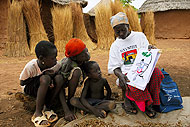This article was published in the April 4, 2009 edition of The Lancet and is reprinted with permission.
Experts are stepping up their eff orts to eradicate guinea worm disease from the world. But the final push will not be easy in the six African countries with remaining cases. Wairagala Wakabi reports.
Africa is edging closer to eradicating guinea worm disease, but insecurity in some endemic areas and fears of cross-border transmission are causing concern among those spearheading the eradication campaign.
Last year saw a 51% reduction in the number of cases reported worldwide to 4647, and now it is hoped that guinea worm will be the next disease after smallpox to be eradicated. According to the Carter Center, which spearheaded the initiative since 1986, in conjunction with WHO and US Centers for Disease Control and Prevention, the number of cases worldwide fell from 3·5 million in 20 countries 22 years ago, and now only affects six African countries-Sudan, Ghana, Mali, Ethiopia, Nigeria, and Niger.
Philip Downs, a Carter Center expert, says that the character of the disease makes it easy to eradicate. "It is easy to diagnose, and while there is no vaccine, it can be relatively easy to develop interventions, through the use of water filters and teaching those with the worms not to walk into water." It is also easy to apply chemicals to water to kill the larvae.
Fresh funding of US$55 million announced last December by the Bill & Melinda Gates Foundation, the UK Department for International Development, and the Carter Center to support the eradication campaign is expected to drive the fi nal push towards eradication. While annoucing the funding, Carter Center founder, former US President Jimmy Carter, said: "The reduction of guinea worm cases by more than 99% proves that when people work together, great positive change is possible."
Yet, observers and campaign officials alike continue to see obstacles to the eradication initiative as it reaches a decisive stage. Instability remains a key challenge. In north-eastern Mali, where the disease is endemic, there has been a surge in violence that made interventions harder. Transmission in that region begins in May, and it is feared if the security situation remains bad then it will fuel transmission. In Sudan, remote areas and those which have in the past had insecurity in the south of the country have disproportionately higher infestation rates. In the secure north, the disease has been eradicated. Sudan currently has the biggest number of cases worldwide at about 3600, although the caseload fell by 39% last year.
Emmanuel Otaala, Uganda's outgoing health minister, says there is need for cross-border surveillance, pointing to the possibility for countries such as Sudan to export the disease to neighbouring states. Burkina Faso and Togo have recently imported cases from Ghana, a secure country but one with 500 cases.
"We need to deal with imported cases by inaugurating guinea worm surveillance systems. We have been helping to set up basic infrastructure for disease surveillance, but more resources are needed from national governments", said Downs. "The surveillance systems need to be sensitive enough so that if there are imported cases, they are able to detect them and prevent recontamination of water sources."
Ghana's cases also have eradication officials concerned. Most cases in this country are in the northern region, affecting large communities with populations of up to 20 000 people that live along major roads. "You would imagine that such big populations have safe water. But boreholes and wells break down or dry up, so people turn to water collected in dams", explained an official. He added that it is harder to set up surveillance systems in such semi-urban settings, although Ghana is beginning to establish surveillance systems in aff ected areas, and provide safe water sources.
Since 1986, six previously endemic countries have been certifi ed by WHO as disease free, and eight others that have stopped transmission are awaiting certification. It is expected that during 2009, only Ghana, Mali, and Sudan will still be transmitting the disease.
Experts stress that the last cases of an eradication campaign are the most difficult and expensive to eliminate. Although infected cases drop, surveillance of countries, including the smallest communities in the most remote areas, needs to be intensified to prevent outbreaks and setbacks, they say. And, in the case of guinea worm disease, which has a 1-year incubation period, there is a very high cost of maintaining a broad and sensitive monitoring system and providing a rapid response when necessary.

Photo credit: The Carter Center
(Click to enlarge)
A Red Cross Society volunteer teaches children in Ghana about Guinea worm disease.
Please sign up below for important news about the work of The Carter Center and special event invitations.